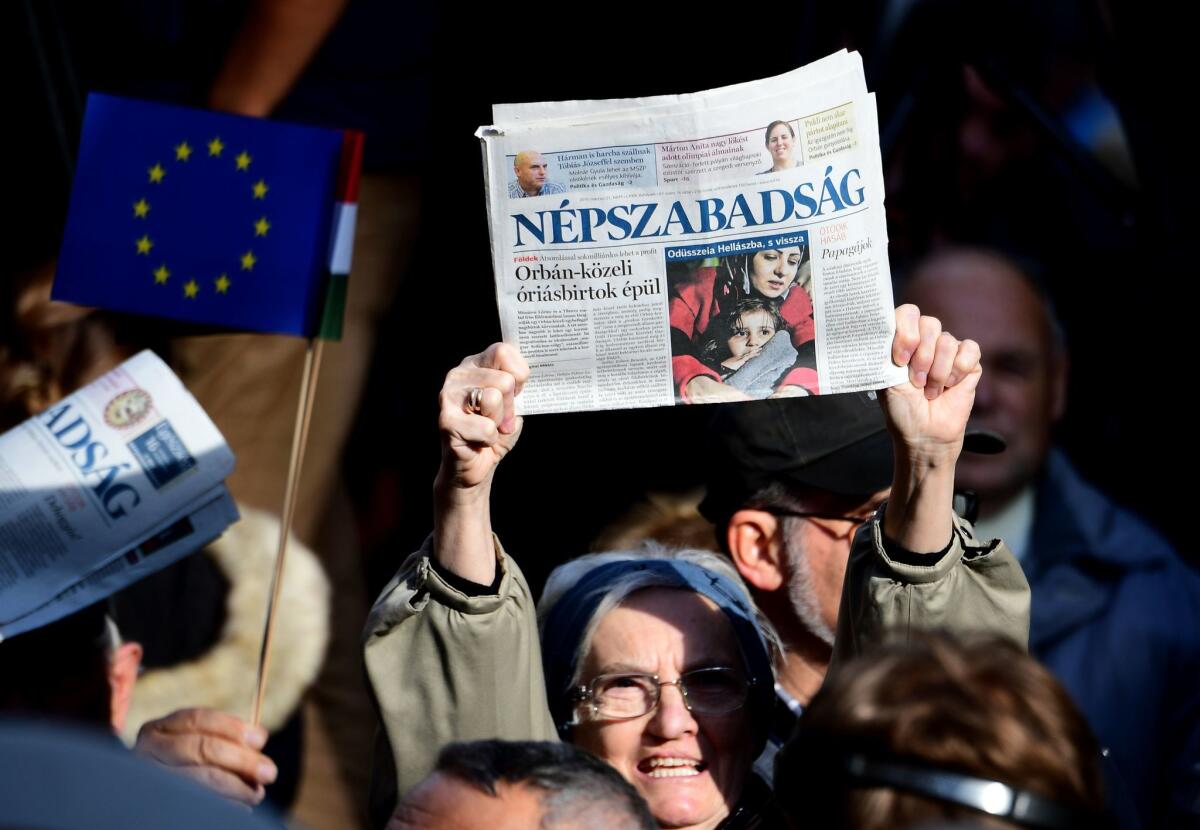A newspaper’s closure sparks fury — and concern over Hungary’s rightward drift

- Share via
Reporting from BUDAPEST, Hungary — In a modest grocery store on the fringes of downtown Budapest, Gabor Felkai shuffles about in a faded checked shirt, serving his regulars shots of bitter coffee and lamenting what he sees as the fading of democracy in his homeland.
He can see it in the vacant spot in his shop, amid the wine and whiskey, breads and cheeses, where Hungary’s leading leftist newspaper once perched.
For much of its history, the daily Nepszabadsag (“Liberty of the People”) was the mouthpiece of the ruling Communist Party. It became a strong independent voice in the years after the collapse of communism in Eastern Europe.
But the country has turned sharply to the right in recent years, and Napszabadsag recently shut down after about 60 years in print. Its owners said it was losing money, but many Hungarians suspected the hidden hand of the government.
To its loyal readers, the newspaper’s demise was an ominous sign of the times.

“It was the last really left-wing paper,” said Felkai, 62. He pointed to a small handwritten sign in the newspaper rack near the door. It read: “This space is for Nepszabadsag.”
In Hungary, the shutdown of Nepszabadsag — often critical of the ruling Fidesz party — has highlighted what media watchdogs and rights groups describe as an accelerating erosion of media freedom in this Central European nation of 10 million.
In 2015, public broadcasters were instructed to avoid showing images of refugee women and children, as the government sought to capitalize on anti-immigration sentiment. That same year border police assaulted at least seven foreign reporters covering the refugee crisis.
Many journalists talk of increasing self-censorship under political and economic pressure. In 2014, the editor in chief of the popular website Origo was fired, seemingly under government pressure for reporting about ministerial trips abroad. And last month, the broadcasting license of Class FM expired, meaning Hungary now has only four national radio stations, each state-run, according to the Budapest Beacon.
At Nepszabadsag, the end came with little warning. One day in October, Nepszabadsag’s reporters crammed photographs and notebooks into boxes as they prepared to move into a new headquarters. The sports writers stayed late into that Friday night, to finish reporting about an international soccer match.
“We were supposed to go the new workplace at noon on Sunday,” said Nepszabadsag’s former assistant editor in chief, Marton Gergely, “to eat pizza, have some drinks and put together the Monday edition.”
But the next morning, “there was a knock on my door,” Gergely said. “It was the delivery service with a letter for me. It said that I am suspended from work, that I am prohibited from entering the company’s premises or using my email account.”
The paper had been shut down.
“I couldn’t believe it; I’ve spent my entire career, 15 years, at the paper,” he said.
In a statement published on the newspaper’s website, Nepszabadsag’s owners said that the newspaper’s dwindling circulation and losses of about $17 million made continued publication impossible, although they hinted at a future restart.
However, many Hungarians suspect that the government, led by the increasingly authoritarian prime minister, Viktor Orban, orchestrated the shutdown behind the scenes, accusations that the government denies.
“The government would in no way like to infringe on the freedom of the press by becoming involved in the publisher’s decision,” government spokesman Bence Tuzson said in a statement published on the government website. “The true violation of the freedom of the press would be if the government interfered with the decision of a media operator.”
That wasn’t how many Hungarians saw it.
Over the following days, protesters took to the streets. Crowds gathered for concerts highlighting the paper’s plight, donning shirts featuring the various Nepszabadsag nameplates of the last 60 years.
“They [closed] it because the newspaper told the truth,” said Felkai, the store owner, a badge in the colors of the Hungarian flag pinned to his chest.
The paper’s final edition splashed a story across its front page about Orban’s response to a prominent minister’s use of a luxury helicopter to attend a wedding. It was the last in a series of investigative reports into corruption that had come to define the newspaper in recent years.
“Corruption is real and it is every day. It is the feeling we have when we go to a doctor, when we are stopped by police, and how politics is done in this country,” said Gergely. “Orban didn’t decide to crack down on corruption; instead, he decided to crack down on those who are reporting on it.”
Nepszabadsag was founded during the bloody Hungarian revolution of 1956, as Soviet armor rolled through the streets of Budapest, seeking to crush an initially student-led rebellion challenging Moscow’s patronage. For much of its history, it was the newspaper of the Communist Party.
“It was a little bit spooky,” says Ferenc Hammer, chair of the media and communications department at Eotvos Lorand University in Budapest. “For example, if there was an article critical of someone in the paper, that person probably did not get a good sleep.”
After the 1991 Soviet collapse, Hungary was roiled by dramatic political swings, with the nationalist right and the increasingly neo-liberal left vying to put their stamp on the country.
Orban, a lawyer with sharp political acumen, rose to prominence on a reformist platform in the early 1990s. In 2010, his party secured a supermajority in the Hungarian parliament, running on a populist ticket defined by conservative, xenophobic rhetoric and opposition to liberalism.
The appeal of the party’s nationalism has grown in the last couple of years as Europe has grappled with a massive flow of migrants from Syria, North Africa and elsewhere. Orban’s management of the crisis — the government built a fence along its southern border last year — solidified his position as the standard-bearer of the European right.
On a continent where right-wing movements carry echoes of a bloody past, many observers fear that Budapest is setting a precedent that other European nations with resurgent right wings, notably France, Poland and Slovakia, may follow.
“One of the first things they did was completely overhaul the media law,” said Lydia Gall, a lawyer and researcher with Human Rights Watch Central Europe. “Since then, we have seen a continued erosion of the rule of law.”
Critics contend that the changes marked the beginning of an assault on the free press, as Orban sought to exert control and establish what he called an “illiberal democracy.”
Orban’s party used its supermajority in parliament to overhaul the National Media and Info-Communications Authority. In one prominent case, the media authority refused to renew the frequency of an opposition radio station, Klubradio, leading to a protracted, costly battle in the courts.
Meantime, oligarchs close to Orban bought magazines and television stations, at times with state-backed loans; journalists were barred from entering parliament; freedom-of-information requests were made more difficult; and advertising contracts were subtly directed to newspapers sympathetic to the government.
Nepszabadsag, which had been privatized after the collapse of communism, was sold to the Swiss media giant Ringier in 2005. It maintained its left-of-center leanings and ties to the country’s Socialist Party, which held a roughly 25% stake in the paper.
However, through a complex series of transactions, it eventually was sold to the Mediaworks company, owned by Vienna Capital Partners, which closed it in early October. Within weeks, Mediaworks was sold to a holding company reportedly controlled by a close childhood friend of Orban’s.
Watchdogs warn that the silencing of critical voices stifles debate and puts the vulnerable at risk. Government-controlled media bombard Hungarians with reports about the dangers of refugees.
However, some of Orban’s supporters contend that the opposition is exaggerating the situation.
Standing outside the Ethnographic Museum, a young woman, Csillag, who would give only her first name for privacy reasons, said that she did not believe the “government is attacking the media.”
Inside, the 2016 World Press Photography Exhibition was on display: images of desperate migrants aboard a flimsy raft; Syrians covered in blood after airstrikes; children scurrying through gaps in razor-wire border fences.
“If they were [attacking the media], they would ban this exhibition,” said Csillag.
Felkai, the shopkeeper, is coping with the loss of his favorite newspaper by staging a subtle, one-man protest. He has taken to hiding the pro-government paper, Magyar Idok, behind the counter.
“It’s rubbish,” he said. “I’m not putting it on my stand.”
Johnson is a special correspondent.
ALSO
Hundreds protest outside newspaper after journalists jailed in growing crackdown in Turkey
White nationalists’ ‘man in the White House’? Bannon appointment provokes angry rebukes
More to Read
Sign up for Essential California
The most important California stories and recommendations in your inbox every morning.
You may occasionally receive promotional content from the Los Angeles Times.










